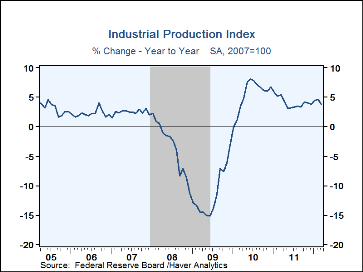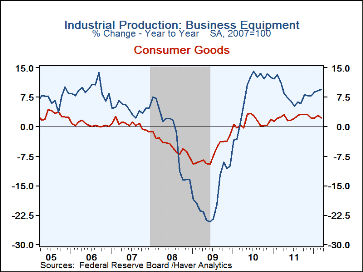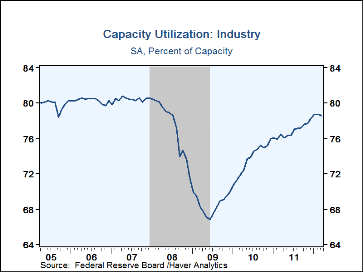 Global| Apr 17 2012
Global| Apr 17 2012U.S. Industrial Output Remains Unchanged; Factory Output Slips
by:Tom Moeller
|in:Economy in Brief
Summary
There's been no forward momentum recently in U.S. production activity. Industrial production was unchanged last month (3.8% y/y) following an unrevised no-change during February. The latest figure again disappointed Consensus [...]
 There's been no forward momentum recently in U.S. production activity.
Industrial production was unchanged last month (3.8% y/y) following an unrevised
no-change during February. The latest figure again disappointed Consensus
expectations for a 0.3% increase according to Action Economics. Factory
sector output fell 0.2% (+4.9% y/y) following strength during the prior
three months. Utility output recovered 1.5% (-4.6% y/y) while mining
ticked up 0.3% (4.2% y/y).
There's been no forward momentum recently in U.S. production activity.
Industrial production was unchanged last month (3.8% y/y) following an unrevised
no-change during February. The latest figure again disappointed Consensus
expectations for a 0.3% increase according to Action Economics. Factory
sector output fell 0.2% (+4.9% y/y) following strength during the prior
three months. Utility output recovered 1.5% (-4.6% y/y) while mining
ticked up 0.3% (4.2% y/y).
Business equipment production remained firm relative to other sectors last month. Its modest 0.2% rise followed several strong months and its 9.6% y/y increase was several times the gains in most other sectors. Indeed, consumer goods output fell 0.2% (+2.2% y/y) in March. The drop reflected a 0.4% decline (+12.6% y/y) in autos, a 2.3% falloff (-0.6% y/y) in appliances and a 2.3% drop (-0.8% y/y) in clothing. Showing strength were computers, audio & video equipment where output rose 1.1% (7.4% y/y). Excluding both the high-tech and auto sectors, output dipped 0.1% (+3.4% y/y) following no-change in February.
Capacity utilization slipped to 78.6% last month. In manufacturing alone utilization fell to 77.8% but remained up from the recession low of 64.4%. Overall capacity is estimated to have risen 1.1% y/y following a 0.2% dip last year and a 2.2% decline during 2010. In the factory sector, capacity rose 0.7% y/y and excluding the high-tech industries, it increased 0.6%.
Industrial production and capacity data are included in Haver's USECON database, with additional detail in the IP database. The expectations figure is in the AS1REPNA database.
The World Economic Outlook from the International Monetary Fund can be found here.
| Industrial Production (SA, % Change) | Mar | Feb | Jan | Mar Y/Y | 2011 | 2010 | 2009 |
|---|---|---|---|---|---|---|---|
| Total Output | 0.0 | 0.0 | 0.7 | 3.8 | 4.1 | 5.4 | -11.4 |
| Manufacturing | -0.2 | 0.9 | 1.1 | 4.9 | 4.3 | 5.7 | -13.8 |
| Consumer Goods | -0.2 | 0.5 | 0.3 | 2.2 | 2.3 | 1.1 | -6.9 |
| Business Equipment | 0.2 | 1.3 | 2.0 | 9.6 | 8.2 | 8.3 | -18.2 |
| Construction Supplies | -1.4 | 1.9 | -0.1 | 6.8 | 5.6 | 3.8 | -22.9 |
| Materials | 0.2 | -0.9 | 0.8 | 3.5 | 4.6 | 8.4 | -11.5 |
| Utilities | 1.5 | 0.1 | -1.9 | -4.6 | -0.3 | 3.6 | -2.5 |
| Capacity Utilization (%) | 78.6 | 78.7 | 78.7 | 76.5 | 76.8 | 73.7 | 68.5 |
| Manufacturing | 77.8 | 78.0 | 77.5 | 74.7 | 75.0 | 71.3 | 65.5 |
Tom Moeller
AuthorMore in Author Profile »Prior to joining Haver Analytics in 2000, Mr. Moeller worked as the Economist at Chancellor Capital Management from 1985 to 1999. There, he developed comprehensive economic forecasts and interpreted economic data for equity and fixed income portfolio managers. Also at Chancellor, Mr. Moeller worked as an equity analyst and was responsible for researching and rating companies in the economically sensitive automobile and housing industries for investment in Chancellor’s equity portfolio. Prior to joining Chancellor, Mr. Moeller was an Economist at Citibank from 1979 to 1984. He also analyzed pricing behavior in the metals industry for the Council on Wage and Price Stability in Washington, D.C. In 1999, Mr. Moeller received the award for most accurate forecast from the Forecasters' Club of New York. From 1990 to 1992 he was President of the New York Association for Business Economists. Mr. Moeller earned an M.B.A. in Finance from Fordham University, where he graduated in 1987. He holds a Bachelor of Arts in Economics from George Washington University.








